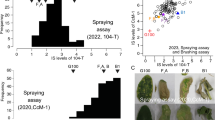Abstract
We present a new linkage map for sugar beet (Beta vulgaris) which has been developed using a population segregating for genetic factors that confer tolerance to the leaf spot fungus (Cercospora beticola), the causal factor of leaf spot disease in sugar beet). In the F2 population studied, a subset of 36 RFLP probes, mapping on eight out of the nine linkage groups of sugar beet, provided the anchor markers to assign chromosomes. A total of 224 markers, including RFLPs, AFLPs, SCARs and microsatellites, were mapped. Estimates of leaf damage in F2 and test-cross families were repeated at different stages of plant development. Each set of data was analysed as such. An average estimate was also considered. QTLs with highly significant LOD scores revealed both by the F2 and test-cross analyses were localized on linkage groups 2, 6 and 9. Linkage groups 4 and 5 gave a clear indication of the presence of a QTL only when F2 data were considered. One highly significant QTL with a LOD of 16.0 was revealed only by the data obtained under conditions of artificial inoculation. This QTL maps at position 90 on chromosome 3.
Similar content being viewed by others
Author information
Authors and Affiliations
Additional information
Received: 3 February 1999 / Accepted: 20 February 1999
Rights and permissions
About this article
Cite this article
Schäfer-Pregl, R., Borchardt, D., Barzen, E. et al. Localization of QTLs for tolerance to Cercospora beticola on sugar beet linkage groups. Theor Appl Genet 99, 829–836 (1999). https://doi.org/10.1007/s001220051302
Issue Date:
DOI: https://doi.org/10.1007/s001220051302




